Rage Against the Virtual Machine:
Hindering Dynamic Analysis of Android Malware
Thanasis Petsas,* Giannis Voyatzis,* Elias Athanasopoulos,*
Michalis Polychronakis,† Sotiris Ioannidis*
*Institute of Computer Science, Foundation for Research and Technology—Hellas, Greece
{petsas, jvoyatz, elathan, sotiris}@ics.forth.gr, mikepo@cs.columbia.edu
†Columbia University, USA
ABSTRACT
Antivirus companies, mobile application marketplaces, and the se-
curity research community, employ techniques based on dynamic
code analysis to detect and analyze mobile malware. In this paper,
we present a broad range of anti-analysis techniques that malware
can employ to evade dynamic analysis in emulated Android envi-
ronments. Our detection heuristics span three different categories
based on (i) static properties, (ii) dynamic sensor information, and
(iii) VM-related intricacies of the Android Emulator. To assess the
effectiveness of our techniques, we incorporated them in real mal-
ware samples and submitted them to publicly available Android dy-
namic analysis systems, with alarming results. We found all tools
and services to be vulnerable to most of our evasion techniques.
Even trivial techniques, such as checking the value of the IMEI, are
enough to evade some of the existing dynamic analysis frameworks.
We propose possible countermeasures to improve the resistance of
current dynamic analysis tools against evasion attempts.
1.
INTRODUCTION
The popularity of Android, in conjunction with the openness of
the platform, has made it an attractive target for attackers [13]. The
antivirus and research community have responded to this increas-
ing security concern through malicious app analysis services and
tools. Google has also created Bouncer [1], a service that auto-
matically scans and detects malicious apps. Scanning an app for
inferring its potentially hidden malicious activities can be based on
static [22, 25] and dynamic analysis [14, 17, 19, 28]. Unfortunately
both static and dynamic analysis approaches can be evaded. As
far as static analysis is concerned, researchers have demonstrated
a series of techniques which can exploit currently available analy-
sis tools [30]. As we demonstrate in this work, dynamic analysis
using emulation for inspecting Android malware is not perfect ei-
ther. A malicious program can try to infer whether it runs in an
emulated environment, and therefore evade detection by pausing
all malicious activities.
Specifically, in this paper we investigate how Android applica-
tions can infer whether they are running on an emulated ARM ar-
chitecture or on actual hardware. We begin with the creation of
Permission to make digital or hard copies of all or part of this work for personal or
classroom use is granted without fee provided that copies are not made or distributed
for profit or commercial advantage and that copies bear this notice and the full cita-
tion on the first page. Copyrights for components of this work owned by others than
ACM must be honored. Abstracting with credit is permitted. To copy otherwise, or re-
publish, to post on servers or to redistribute to lists, requires prior specific permission
and/or a fee. Request permissions from Permissions@acm.org.
EuroSec’14, April 14 - 17 2014, Amsterdam, Netherlands.
Copyright 2014 ACM 978-1-4503-2715-2/14/04 ...$15.00.
http://dx.doi.org/10.1145/2592791.2592796.
a taxonomy of possible ways for identifying features of the exe-
cution environment using sets of heuristics. Our heuristics span a
wide spectrum of sophistication. Many of them are simple, and can
be thwarted by simple modifications to the emulated environment
for confusing the heuristic, such as using realistic values for static
properties like the serial number of the device. Others are more
robust, as the emulated environment needs to incorporate realistic
output of mobile sensors, such as the accelerometer. Finally, we
present a set of heuristics that require design changes in the actual
emulated environment to be defeated.
To assess the importance of our findings we repackaged a set of
actual malware samples, by incorporating the developed heuristics,
and submitted them to online analysis tools. Surprisingly, all of the
tested analysis tools could be evaded using some of our heuristics.
There was no single malware analysis service that could cope with
all of the tested heuristics. Furthermore, at least 5 of the 12 analy-
sis tools we checked can be evaded by using heuristics as simple as
checking the IMEI value. More complex heuristics based on virtual
machine intricacies could evade all but four of the tested services.
Those four services do not support native code, and thus can only be
used by reviewing a subset of Android apps. Finally, all tested ser-
vices were vulnerable to sensor-based heuristics. We argue that cur-
rent practices for malware analysis can be easily evaded by demon-
strating that actual malware can conceal its malicious functionality
from publicly available malware analysis services. We propose a
set of countermeasures for making emulated Android app analysis
environment more robust to evasion attempts.
2. ANTI-ANALYSIS TECHNIQUES
Anti-analysis techniques that can be employed by Android apps
to evade detection can be classified in three categories: (a) static
heuristics, based on static information always initialized to fixed
values in the emulated environment, (b) dynamic heuristics, based
on observing unrealistic behavior of various sensors, and (c) hy-
pervisor heuristics, based on incomplete emulation of the actual
hardware. Table 1 provides a summary of all categories, along with
some representative examples.
2.1 Static Heuristics
The static set includes heuristics that can be used for detecting
emulated environments by checking the presence and the content
of unique device identifiers, such as the serial number (device ID),
the current build version, or the layout of the routing table.
Device ID. Each smartphone contains an IMEI (International Mo-
bile Station Equipment Identity), which is a unique number identi-
fying it in the GSM network. The IMEI has already been used by
malicious Android apps to hinder analysis by malware detection
tools running on emulators [2]. Another mobile device identifier is
1
�
Category
Type
Examples
Static
Pre-initialized static information
IMEI has a fixed value, routing table is fixed
Dynamic
Hypervisor
Dynamic information does not change
Sensors produce always the same value
VM instruction emulation
Native code executes differently
Table 1: A summary of the main types of VM detection heuristics that can be used by mobile malware, along with representative examples.
the IMSI (International Mobile Subscriber Identity), which is asso-
ciated with the SIM card found in the phone. Our simplest evasion
heuristics are based on checking these identifiers, e.g., whether the
IMEI is equal to null, which is true for the default configuration
of Android Emulator. We will refer to this kind of heuristics using
the abbreviation idH.
Current build. Another way to identify emulated environments is
by inspecting information related to the current build, as extracted
from system properties. For instance, the Android SDK provides
the public class Build, which contains fields such as PRODUCT,
MODEL, and HARDWARE, that can be examined in order to detect
if an application is running on an emulator. For example, a default
Android image on an emulator has the PRODUCT and MODEL fields
set to google_sdk, and the HARDWARE field set to goldfish.
We have implemented a number of heuristics based on this kind of
checks, to which we refer as buildH.
Routing table. An emulated Android device by default runs behind
a virtual router within the 10.0.2/24 address space, isolated from the
host machine’s network. The emulated network interface is config-
ured with the IP address 10.0.2.15. The configured gateway and
DNS servers have also specific values. We use these networking
properties as another detection heuristic. Specifically, the heuris-
tic checks listening sockets and established connections (through
/proc/net/tcp), and attempts to find a port number associated
with addresses 10.0.2.15 and 0.0.0.0, as an indication of an emu-
lated environment. We refer to this heuristic as netH.
2.2 Dynamic Heuristics
Mobile phones are equipped with a variety of sensors, including
an accelerometer, gyroscope, GPS, gravity sensor, etc. Essentially,
these sensors output values based on information collected from the
environment, and therefore simulating them realistically is a chal-
lenging task. The existence of sensors is a key difference between
smartphones and conventional computing systems. The increasing
number of sensors on smartphones presents new opportunities for
the identification of actual mobile devices, and thus for the differ-
entiation and detection of emulators. For instance, there are studies
focused on smartphone fingerprinting based on sensor flaws and
imperfections [3, 20]. Such fingerprinting approaches can be lever-
aged for the detection of emulated environments.
By default, the Android emulator cannot simulate device move-
ments; this can be achieved through additional sensor simulators [4].
Current builds of the Android Emulator also support partially or
not at all simulation of other types of sensors. In our testing of the
available simulated sensors, we found that they generated the same
value at equal time intervals equal in average to 0.8 second with
negligible standard deviation (equals to 0.003043). The CDF of the
intervals between accelerometers’ events as observed in an Android
Emulator running for a couple of minutes is shown in Figure 1. We
found that the CDF for the rest of the sensors in Android Emulator
follows a similar pattern. We implemented our sensor-based heuris-
tics by taking advantage of the SensorManager [5] class of the
Android API. We developed an Android Activity that attempts to
register a sensor listener to monitor its output values using the fol-
lowing approach. First, we try to register a sensor listener. If the
2
1
0.8
0.6
0.4
0.2
F
D
C
0
0.7
0.75
0.8
0.85
0.9
Accelerometer’s events interval (sec)
Figure 1: The CDF of the intervals between accelerometers’ events
as observed in an Android Emulator running for a few minutes.
registration fails, then the execution probably takes place in an em-
ulated environment (except in the case of an actual device that does
not support the specific sensor). Otherwise, if sensor registration
is successful, then we check the onSensorChanged callback
method, which is called when sensor values change. If the sensor
values or time intervals observed are the same between consecutive
calls of this method, then we assume that the app is running on an
emulated environment and we unregister the sensor listener. We
implemented this sensor-based heuristic for the accelerometer (ac-
celH), magnetic field (magnFH), rotation vector (rotVecH), prox-
imity (proximH), and gyroscope (gyrosH) sensors.
2.3 Hypervisor Heuristics
Identifying QEMU scheduling. Our first hypervisor heuristic is
related to QEMU scheduling [26], and the fact that QEMU does
not update the virtual program counter (PC) at every instruction
execution for performance reasons. As translated instructions are
executed natively, and increasing the virtual PC needs an additional
instruction, it is sufficient and faster to increase the virtual PC only
when executing instructions that break linear execution, such as
branch instructions. This means that if a scheduling event occurs
during the execution of a basic block, it would be impossible for
the virtual PC to be reconstructed. For this reason, scheduling in
a QEMU environment happens only after the execution of a basic
block, and never within its execution.
A proof of concept QEMU BT detection technique based on a
histogram of the scheduling addresses of a thread has already been
implemented [26]. In a non-emulated environment, a large set of
various scheduling points will be observed, as scheduling can hap-
pen at an arbitrary time, whereas in an emulated environment, only
a specific scheduling point is expected to be seen, at the beginning
of a basic block, as scheduling happens after the execution of a com-
plete basic block. We have implemented this technique and used it
in our experiments as an extra heuristic, abbreviated as BTdetectH.
In Figure 2, we show the different behaviors of scheduling points
by running this detection heuristic on an Android Emulator and on
a real device.
Identifying QEMU execution using self-modifying code. As a
second heuristic, we implemented a novel QEMU detection tech-
nique (we call xFlowH) based on the fact that QEMU tracks modi-
�
Device
Emulator
F
D
C
1
0.8
0.6
0.4
0.2
0
Family
BadNews
BaseBridge
Bgserv
DroidDream
DroidKungFu
FakeSMS Installer net.mwkekdsf
Geinimi
Zsone
JiFake
Fakemart
com.sgg.sp
com.mj.iCalendar
android.packageinstaller
com.android.blackmarket
Package name
Heuristic
ru.blogspot. playsib.savageknife magnFH
com.keji.unclear
com.android. vending.sectool.v1 netH
com.droiddream. bowlingtime
com.atools.cuttherope
accelH
Description
Data extrusion
Root exploit
Bot activity
Root expoit
gyrosH
Root exploit
rotVecH
SMS trojan
proximH
Bot avtivity
buildH
SMS trojan
idH
BTdetectH SMS trojan
SMS trojan
xFlowH
0
5
10
15
20
25
30
35
Scheduling point (basic block offset)
Figure 2: Due to optimizations, QEMU does not update the vir-
tual PC on every instruction execution, and therefore many of the
scheduling events that can take place are not exhibited on an emu-
lated environment.
fications on code pages.1 The technique is based on incurring vari-
ations in execution flows between an emulator and a real device
through self-modifying code.
ARM processors include two different caches, one for instructions
accesses (I-Cache) and one for data accesses (D-Cache) [18]. Har-
vard architectures (like ARM) do not ensure coherence between I-
Cache and D-Cache. Therefore, the CPU may execute an old (pos-
sibly invalid) piece of code after a newly one has already been writ-
ten in main memory. This issue can be resolved by enforcing con-
sistency between the two caches, which can be achieved through
two operations: (a) cleaning main memory, so as the newly writ-
ten code lying in the D-Cache to be moved into main memory; and
(b) invalidating the I-Cache so that it can be repopulated with the
new content of the main memory. In native Android code, this can
be done through the cacheflush function, which carries out the
above operations through a system call.
We implemented an example of self-modifying (native) code that
uses a memory segment with write and execute rights which is over-
written several times, in a loop, with the content (code) of two dif-
ferent functions, f1 and f2, alternately. After each code patch,
we run the code of this segment, which in turn runs either f1 or
f2. These are two simple functions which both append their name
at the end of a global string variable, so that the function call se-
quence can be inferred. To achieve an alternating call sequence,
we have to synchronize the caches through a cacheflush call as
described previously.
We ran this code, along with the extra calls for cache synchro-
nization after each patch, on a mobile device and on the emulator,
with the same results—each execution produced a consistent func-
tion call sequence as determined by the loop. Then, we performed
the same experiment, but this time excluded the cacheflush
calls. As expected, on the mobile device we observed a random
call sequence for each run. As the caches are not synchronized be-
fore each call, the I-Cache may contain stale instructions because it
is not explicitly invalidated. Interestingly, we found that this does
not happen on the emulator. Instead, the call sequence was exactly
the same as in the first case, when the caches were consistent before
each function call. This behavior is expected, as QEMU discards
its translated block for the previous version of the code, and re-
translates the newly generated code, as it tracks modifications on
code pages and ensures that the generated code always matches the
target instructions in memory [16].
1 A similar heuristic has been developed independently and con-
currently with this work [6]. At the time of writing, that work does
not include any evaluation of the heuristic with real-world analysis
tools and services.
3
Table 2: Malware samples used for our study.
3.
IMPLEMENTATION
We have implemented the heuristics described in Section 2 us-
ing the Android SDK. For BTdetectH and xFlowH, we used the
Java Native Interface (JNI) to invoke the native code that imple-
ments the functionality of each heuristic. We developed a simple
Android application (test app) that runs our heuristics in the back-
ground, and for each one collects information about its effective-
ness. The collected data is sent to an HTTP server to be stored
in a local database. Moreover, we incorporated our heuristics in a
set of well known Android malicious apps. For this purpose, we
used Smali/Baksmali [7] along with Apktool [8], which we used
for disassembling and reassembling process. The incorporation of
our heuristics in malicious apps was done by patching the Smali
Dalvik bytecode (generated by the disassembly process) with the
Smali code of each heuristic, which was previously extracted from
our developed test app. Each malicious app was modified to carry
one of the implemented heuristics, as listed in Table 2. At first, we
ran each original sample as is, both on the emulator and on a real
device, and observed through the logcat command of Android
logging system the initial spawned Android activities and services.
Afterwards, we patched these components with one of the heuris-
tics, which, depending on the detection result, decides whether to
continue the execution of the component or not.
We tested the repackaged applications both on multiple emula-
tors and actual devices to make sure that the malicious behavior is
triggered only when the execution happens on a real device. Note
that apart from the above changes in the produced code of malicious
apps, no other additions are needed in any other parts of the APK
files, except for the following cases. The idH heuristic requires
the READ_PHONE_STATE permission explicitly declared in the
Android Manifest file, to be able to retrieve information about the
phone state. For the BTdetectH and xFlowH heuristics, a new
folder named lib needs to be created inside the top level directory
containing the desired native code in the form of shared libraries.
4. EXPERIMENTAL EVALUATION
In this section, we present the results of our evaluation regarding
the effectiveness of the heuristics we presented in Section 2. Each
heuristic was added in real malware and analyzed with various dy-
namic analysis services and tools. For each case, we record which
of the heuristics managed to detect the emulated environment and
which failed. We first describe the malware dataset and the dy-
namic analysis services we used, then proceed with a summary of
our methodology, and finally present and discuss our findings.
4.1 Data and Tools
Malware Samples. We patched a number of well known Android
malicious apps with the code of our detection techniques using the
process described in Section 3. We used 10 samples from differ-
ent malware families with distinct capabilities, including root ex-
�
Type Tool
Offline DroidBox
DroidScope
TaintDroid
Andrubis
SandDroid
ApkScan
VisualThreat
Tracedroid
CopperDroid
O nline
Web Page
http://code.google.com/p/droidbox/
http://code.google.com/p/decaf-platform/
wiki/DroidScope
http://appanalysis.org/
http://anubis.iseclab.org/
http://sanddroid.xjtu.edu.cn/
http://apkscan.nviso.be/
http://www.visualthreat.com/
http://tracedroid.few.vu.nl/
http://copperdroid.isg.rhul.ac.uk/
copperdroid/
APK Analyzer http://www.apk-analyzer.net/
ForeSafe
Mobile Sandbox http://mobilesandbox.org/
http://www.foresafe.com/
Table 3: Android malware analysis tools and services used in our
evaluation.
ploits, sensitive information leakage, SMS trojans, and so on. All
tested samples are publicly available and are part of the Contagio
Minidump [9]. Table 2 provides a summary of the set of malware
samples used, along with the heuristics used in each case.
Dynamic Analysis Services. The Android dynamic analysis ser-
vices and tools used in our evaluation are listed in Table 3. We
used both standalone tools available for download and local use, as
well as online tools which analyze submitted samples online.
We used three popular open source Android app analysis tools:
DroidBox [10], DroidScope [35], and TaintDroid [21]. All three
tools execute Android applications in a virualized environment and
produce analysis reports. DroidBox offers information about about
incoming/outgoing traffic, read/write operations, services invoked,
circumvented permissions, SMS sent, phone calls made, etc. Droid-
Scope performs API-level as well as OS-level profiling of Android
apps and provides insight about information leakage. TaintDroid is
capable of performing system-wide information flow tracking from
multiple sources of sensitive data in an efficient way.
In addition to standalone tools, we also used publicly available
online services that dynamically analyze Android apps, briefly de-
scribed below. Andrubis [14] performs both static and dynamic
analysis on unwanted Android apps. SandDroid performs permis-
sion/component analysis as well as malware detection/classifica-
tion analysis. ApkScan provides information including file accesses,
network connections, phone calls, SMS sent, information leakage,
and cryptographic activities. VisualThreat provides information
spanning from network activity and data leakage to malware fam-
ily detection through API correlation. TraceDroid emulates some
actions, when analyzing apps, such as user interaction, incoming
calls, SMS messages, which can reveal malicious intents. Copper-
Droid [31] is built on top of QEMU and performs out-of-the-box
dynamic analysis (both OS-level and API-level) of Android mal-
ware. APK Analyzer, ForeSafe and Mobile Sandbox [33] are also
dynamic analysis services, which inspect mobile malware by fol-
lowing similar approaches as the previously mentioned tools.
4.2 Methodology
To evaluate the effectiveness of our heuristics, we follow two dif-
ferent approaches. In the first approach we submit an application
sample that incorporates all of the heuristics, as described in Sec-
tion 3, to each online service of our set. During the analysis, the ap-
plication tests the effectiveness of the heuristics by trying them all
sequentially for inferring if the execution environment is emulated
or not. For each heuristic tried, the app communicates the result to
an HTTP server. After that, we are able to ascertain which of the
heuristics were effective on identifying a virtualized environment
and which were not.
id H
build H
netH
accelH
m agn F H
rotV ec H
H
proxim
gyros H
✓ ✗
✗
✗
✗
✗
✓ ✗
✓ ✗
✓ ✗
✗
✗
✗
✗
✗
✗
✗
DroidBox
✗
DroidScope
✗
TaintDroid
✗
Andrubis
✗
SandDroid
✗
ApkScan
✗
VisualThreat
✗
Tracedroid
✗
CopperDroid
Apk Analyzer ✓ ✓ ✓
✗
✗
ForeSafe
Mobile Sandbox ✓ ✗
✗
✗
✗
✗
✗
✗
✗
✗
✗
✗
✗
✗
✗
✗
✗
✗
✗
✗
✗
✗
✗
✗
✗
✗
✗
✗
✗
✗
✗
✗
✗
✗
✗
✗
✗
✗
✗
✗
✗
✗
✗
✗
✗
✗
✗
✗
✗
✗
✗
✗
✗
✗
✗
✗
✗
✗
✗
✗
✗
✗
✗
✗
B T detectH
xFlo w H
JNI NS
JNI NS
✗
✗
JNI NS
JNI NS
✗
✗
✗
✗
JNI NS
JNI NS
✗
✗
✗
✗
✗
✗
JNI NS
JNI NS
✗
✗
JNI NS
JNI NS
Table 4: Resilience of Android dynamic analysis tools against VM
evasion techniques. “✓” indicates resilient, “✗” indicates vulnera-
ble and “JNI NS” indicates lack of support for JNI.
In order to perform a more realistic analysis and demonstrate
how such heuristics can complicate the work of various dynamic-
analysis tools from drawing correct conclusions, we follow a differ-
ent approach. We modify actual malicious apps so as to incorporate
one of the heuristics, following the process described in Section 3,
and we submit both the original sample and the repackaged one to
each service. Then, we collect the generated reports and compare
them to find differences in the observed behaviors.
4.3 Evasion Results
The results of our evaluation are summarized in Table 4. The first
three rows correspond to standalone analysis tools, and the rest to
online analysis services. We next describe our key findings based
on the collected results.
Finding 1. All the studied dynamic analysis tools and services
are vulnerable to five or more heuristics. As we can see in Table 4,
all the tools we tested can be easily evaded using just one of the
proposed heuristics. Specifically, only 6 out of the 12 tools are re-
silient to our simplest static heuristic idH, which checks the IMEI
of the device. We also found that only one analysis service, Apk
Analyzer, is resilient to all of the static heuristics. In addition, all of
the services are vulnerable to all of the dynamic heuristics, which
are based on using the sensors of the device, as well as the hy-
pervisor heuristics that take advantage of QEMU code generation
intricacies. Note that four tools (DroidBox, TaintDroid, ApkScan,
Apk Analyzer) do not support the execution of native code at all,
which means that we could not test the effectiveness of the hyper-
visor heuristics on them. We were able to infer that through the
exception messages thrown when our test app attempted to load
native code through JNI. All these messages were included in the
HTTP request carrying the results.
Finding 2. All analysis tools failed to correctly infer the malicious
behavior of the repackaged malware samples. We compared all
reports produced by all of our studied tools manually (both offline
and online ones) following our second evaluation approach, and ob-
served that the results are consistent with those found by our first
methodology. That is, the repackaged samples integrating a spe-
cific heuristic managed to hide their malicious behavior success-
fully, and went unnoticed from the tools previously found vulner-
able to the same heuristic. We were able to validate this from the
reduced number of the observed incidents and activities, as well as
from the reduced network traffic observed.
Finding 3. All of the studied online analysis services can be finger-
printed based on inferred information about their execution envi-
ronment. During our analysis, we did not receive any requests with
results from three of the online analysis services (CopperDroid, Vi-
4
�
sual Threat, and APK Analyzer) when following the first approach.
Apparently, those tools analyze apps in an environment with net-
work connectivity disabled. Nonetheless, we observed that if an ap-
plication attempted to write a file during the analysis process then
the filename was reflected on the results page of all these tools.
Thus, we used this trick in order to test the effectiveness of our
heuristics by creating files with special filenames, which indicate
if a particular heuristic was successful or not. So, by using this
approach, we found that we are able to infer information about the
environment, i.e., the Build information, which can be further used
for services fingerprinting.
Finding 4. Only one of the studied tools provides information
about VM evasion attempts. We found, by analyzing the reports
generated by each analysis tool, that only Apk Analyzer has the
feature of detecting evasion behavior in the submitted samples, and
generates relevant alerts in the generated reports (for example we
observed the message: “May tried to detect the virtual machine
to hinder analysis”). Moreover, it reports the ways used to find
the evasion behavior. For example for the repackaged samples con-
taining the idH and buildH heuristics, it mentions the VM artifact
strings found in memory during the execution of the sample. More-
over, the netH heuristic was also not effective on this service as the
default IP address of the network interface used on Android Emula-
tor was modified from 10.0.2.15 to be 192.168.0.24. Nonetheless,
our netH heuristic can be improved if it is changed so as to search
for an arbitrary IP address and the 0.0.0.0 one to be associated with
the ADB port in /proc/net/tcp interface.
Although Apk Analyzer was found resilient to all of our static
heuristics, this was not the case for the dynamic heuristics. Indeed,
we found that using at least one dynamic heuristic, i.e., accelH, into
a repackaged sample is sufficient in order to hide its behavior from
Apk Analyzer. Furthermore, we observed that for all the repack-
aged samples equipped with dynamic heuristics, Apk Analyzer did
not produce alerts related with VM detection attempts.
5. COUNTERMEASURES
Mobile malware with VM detection capabilities can pose a sig-
nificant threat, since it is possible to evade detection and there-
fore nullify the work of dynamic analysis tools that run on emu-
lators. Moreover, Google bouncer, which is the official tool used
in order to detect malicious applications that are about to be pub-
lished in Google Play, is based on dynamic analysis conducted in
the default emulated environment of Android on top of QEMU.
Google Bouncer is also vulnerable to environment detection tech-
niques [11]. In this section we propose a set of defenses that can
be applied in the current emulated environment of Android so as to
make it more realistic.
Emulator Modifications. The Android Emulator can be modi-
fied easily in order to be resistant to our proposed static heuristics.
Mobile device identifiers such as IMEI and IMSI which are used
from our idH heuristic are all configurable in Android emulator. By
looking at the Telephony Manager service in the Android Emula-
tor’s source code and through code analysis, one can find the place
where the modem device is emulated, which is implemented as part
of QEMU [12]. Thus the IMEI, IMSI, as well as other features can
be modified to make the emulator resemble to a real device. The
buildH heuristic that uses the information of the current build can
be easily deceived by modifying the build properties loaded by An-
droid Emulator. These properties are defined in the build.prop
file of Android Emulator’s source code. Finally, the default net-
work properties of Android Emulator can be modified to provide
protection against netH as Apk Analyzer does.
Realistic Sensor Event Simulation. Our second set of heuris-
tics, the dynamic heuristics, are based on the variety of sensors that
a mobile device supports. As already mentioned, Android Emulator
supports trivially detectable sensor simulation, with sensor events
occurring at precise intervals and the produced values not chang-
ing between consecutive events. All the dynamic heuristics (ac-
celH, magnFH, rotVecH, proximH and gyrosH) are based on this
behavior. In order to make all dynamic heuristics ineffective, bet-
ter sensor simulation is required. Nonetheless, realistic simulation
of such hardware components is challenging and requires in-depth
knowledge of both the range of values that these devices can pro-
duce, as well as realistic user interaction patterns. In this context,
external software simulators [4] could be used or record-and-replay
approaches [23], in order to simulate sensor data at real time as an
additional component of the Android Emulator.
Accurate Binary Translation. Binary translation used by QEMU,
on which the BTdetectH heuristic is based, is an essential opera-
tion of the Android Emulator, in which each ARM instruction is
translated into the x86 equivalent in order to be able to run on the
x86-based host machine. BTdetectH is based on a fundamental
operation of the Android Emulator, as already discussed in Sec-
tion 2, and is not trivial to change it. One way to remedy this issue is
by making the binary translation process of QEMU more accurate
to the real execution used in the CPU of a device. That is, the vir-
tual program counter has to be always updated after an instruction,
as happens when instructions are getting executed in a CPU. Thus,
this requires revision and expansion of the current binary transla-
tion operation in QEMU. On the other hand, this approach would
end up producing a higher execution overhead, making QEMU, and
consequently the Android Emulator, easily detectable (e.g., by com-
paring the different execution times that could be observed in an
emulator and in a real device for specific operations).
Hardware-Assisted Virtualization. Another way to cope with
the above issue is to use hardware-assisted virtualization, which
is based on architectural support that facilitates building a virtual
machine monitor and allows guest OSes to run in isolation. For ex-
ample, the upcoming hardware-assisted ARM virtualization technol-
ogy [15] can be used to avoid the process of binary translation and
the problems associated with it. By replacing instruction emulation
(QEMU) with such technology, BTdetectH and xFlowH heuristics
which are based on VM intricacies would become ineffective.
Hybrid Application Execution. Furthermore, another solution
to our hypervisor heuristics would be to use real mobile devices
to execute applications that contain native code. Both these two
heuristics (BTdetectH and xFlowH) require native code execution
in order to act. Hybrid application execution would be the most
secure and efficient way for a dynamic analysis tool against all the
suggested evasion heuristics. That is, application bytecode can run
in a patched version of Android Emulator shielded with all protec-
tion measures described above; when an application is attempting
to load and run native code, then the execution of the native code
can be forwarded and take place on a real device.
6. RELATED WORK
Rastogi et al. [30], evaluated the top commercial anti-malware
products available for Android devices against various obfuscation
techniques. Based on their results, all tested products were found to
be vulnerable to common obfuscation techniques. Their study was
based on static analysis tools. In contrast, we followed a similar
approach to evaluate dynamic analysis tools for Android. Sawar et
al. [32], argue that dynamic taint tracking is ineffective for the
detection of privacy leaks in malicious Android apps, and imple-
mented a set of attacks against TaintDroid that a malware could
5
�
use remove the generated taint marks. In our study, we also used
TaintDroid to evaluate the effectiveness of our heuristics.
There are numerous studies that focus on VM evasion in conven-
tional systems. Raffetseder et al. [29] present a number of tech-
niques for detecting system emulators. Their techniques make use
of various features, such as specific CPU bugs, model-specific reg-
isters (MSRs), instruction length limits, relative performance mea-
surements and many others. Willems et al. [34] present a differ-
ent approach by introducing code sequences that have an implic-
itly different behavior on a native machine when compared with an
emulator. These techniques are based on side-effects of the partic-
ular operations and imperfections in the emulation process, (e.g.,
applications can follow a different control flow path if they are em-
ulated on architectures that support self-modifying code), and are
very similar to our approach used in the xFlowH heuristic.
Paleari et al. [27], present an automatic way of producing red-
pills, that is pieces of code capable to detect whether they are exe-
cuted in a CPU emulator or in a physical CPU. Their approach was
implemented in a prototype, which was used for discovering new
red-pills, involving hundreds of different opcodes, for two popular
CPU emulators: QEMU and BOCHS. Lindorfer et al. [24], intro-
duce DISARM, a system for detecting environment-sensitive mal-
ware. A malware sample is executed in different analysis sand-
boxes, and the observed behaviors from each sandbox are com-
pared in order to detect evasive malwaring. All these studies pro-
pose techniques that can be used by malware for detecting x86
virtualized environments. Our study proposes similar techniques
that can be used by mobile malware and particularly by malicious
apps targeting Android (mostly related to the ARM architecture).
7. CONCLUSION
In this paper, we explored how dynamic analysis can be evaded
by malicious apps targeting the Android platform. We implemented
and tested heuristics of increasing sophistication by incorporating
them in actual malware samples, which attempt to hide their pres-
ence when analyzed in an emulated environment. We tested all
re-packaged malware samples with standalone analysis tools and
publicly available scanning services, and monitored their behavior.
There was no service or tool that could not be evaded by at least
some of the tested heuristics. The work we conducted raises impor-
tant questions about the effectiveness of existing analysis systems
for Android malware. For this reason, we proposed a number of
possible countermeasures for improving the resistance of dynamic
analysis tools for Android malware against VM detection evasion.
Acknowledgements
This work was supported in part by the FP7 projects NECOMA,
OPTET, SysSec and by the FP7-PEOPLE-2010-IOF project XHUN-
TER, funded by the European Commission under Grant Agree-
ments No. 608533, No. 317631, No. 254116 and No. 273765.
8. REFERENCES
[1] http://googlemobile.blogspot.com/2012/02/
android-and-security.html.
[2] http://vrt-blog.snort.org/2013/04/changing-
imei-provider-model-and-phone.html.
[3] http://blog.sfgate.com/techchron/2013/10/10/
stanford-researchers-discover-alarming-
method-for-phone-tracking-fingerprinting-
through-sensor-flaws/.
[4] http://code.google.com/p/openintents/wiki/
SensorSimulator.
[5] http://developer.android.com/reference/
android/hardware/SensorManager.html.
6
[6] https://bluebox.com/corporate-blog/android-
emulator-detection/.
[7] http://code.google.com/p/smali/.
[8] http://code.google.com/p/android-apktool/.
[9] http://contagiominidump.blogspot.com/.
[10] http://code.google.com/p/droidbox/.
[11] https://www.duosecurity.com/blog/dissecting-
androids-bouncer.
[12] https://codepainters.wordpress.com/2009/12/11/
android-imei-number-and-the-emulator/.
[13] 99% of all mobile threats target Android devices. http://www.
kaspersky.com/about/news/virus/2013/99_of_all_
mobile_threats_target_Android_devices.
[14] Anubis/Andrubis: Analyzing Unknown Binaries. http://
anubis.iseclab.org/.
[15] Arm: Virtualization extensions. http://www.arm.com/
products/processors/technologies/
virtualization-extensions.php.
[16] QEMU Internals. http://ellcc.org/ellcc/share/doc/
qemu/qemu-tech.html.
[17] T. Bläsing, A.-D. Schmidt, L. Batyuk, S. A. Camtepe, and
S. Albayrak. An android application sandbox system for suspicious
software detection. In MALWARE, 2010.
[18] Bramley Jacob. Caches and Self-Modifying Code. http://
community.arm.com/groups/processors/blog/2010/
02/17/caches-and-self-modifying-code.
[19] J. Calvet, J. M. Fernandez, and J.-Y. Marion. Aligot: cryptographic
function identification in obfuscated binary programs. In CCS, 2012.
[20] S. Dey, N. Roy, W. Xu, and S. Nelakuditi. Acm hotmobile 2013
poster: Leveraging imperfections of sensors for fingerprinting
smartphones. SIGMOBILE Mob. Comput. Commun. Rev., 17(3),
Nov. 2013.
[21] W. Enck, P. Gilbert, B.-G. Chun, L. P. Cox, J. Jung, P. McDaniel,
and A. N. Sheth. Taintdroid: An information-flow tracking system
for realtime privacy monitoring on smartphones. In OSDI, 2010.
[22] W. Enck, D. Octeau, P. McDaniel, and S. Chaudhuri. A study of
android application security. In USENIX Security,, 2011.
[23] L. Gomez, I. Neamtiu, T. Azim, and T. Millstein. Reran: Timing-
and touch-sensitive record and replay for android. In ICSE, 2013.
[24] M. Lindorfer, C. Kolbitsch, and P. Milani Comparetti. Detecting
environment-sensitive malware. In RAID, 2011.
[25] L. Lu, Z. Li, Z. Wu, W. Lee, and G. Jiang. CHEX: Statically Vetting
Android apps for Component Hijacking Vulnerabilities. In CCS,
2012.
[26] F. Matenaar and P. Schulz. Detecting Android Sandboxes. http://
www.dexlabs.org/blog/btdetect.
[27] R. Paleari, L. Martignoni, G. F. Roglia, and D. Bruschi. A fistful of
red-pills: how to automatically generate procedures to detect cpu
emulators. In WOOT, 2009.
[28] T. H. Project. Android Reverse Engineering (A.R.E.) Virtual
Machine. http://www.honeynet.org/node/783.
[29] T. Raffetseder, C. Kruegel, and E. Kirda. Detecting system
emulators. In ISC, 2007.
[30] V. Rastogi, Y. Chen, and X. Jiang. Droidchameleon: evaluating
android anti-malware against transformation attacks. In ASIA CCS,
2013.
[31] A. Reina, A. Fattori, and L. Cavallaro. A system call-centric analysis
and stimulation technique to automatically reconstruct android
malware behaviors. In EUROSEC, 2013.
[32] G. Sarwar, O. Mehani, R. Boreli, and D. Kaafar. On the effectiveness
of dynamic taint analysis for protecting against private information
leaks on android-based devices. In SECRYPT, 2013.
[33] M. Spreitzenbarth, F. Freiling, F. Echtler, T. Schreck, and
J. Hoffmann. Mobile-sandbox: Having a deeper look into android
applications. In SAC, 2013.
[34] C. Willems, R. Hund, A. Fobian, D. Felsch, T. Holz, and
A. Vasudevan. Down to the bare metal: Using processor features for
binary analysis. In ACSAC ’12, 2012.
[35] L. K. Yan and H. Yin. DroidScope: Seamlessly reconstructing the
OS and Dalvik semantic views for dynamic Android malware
analysis. In USENIX Security, 2012.
�
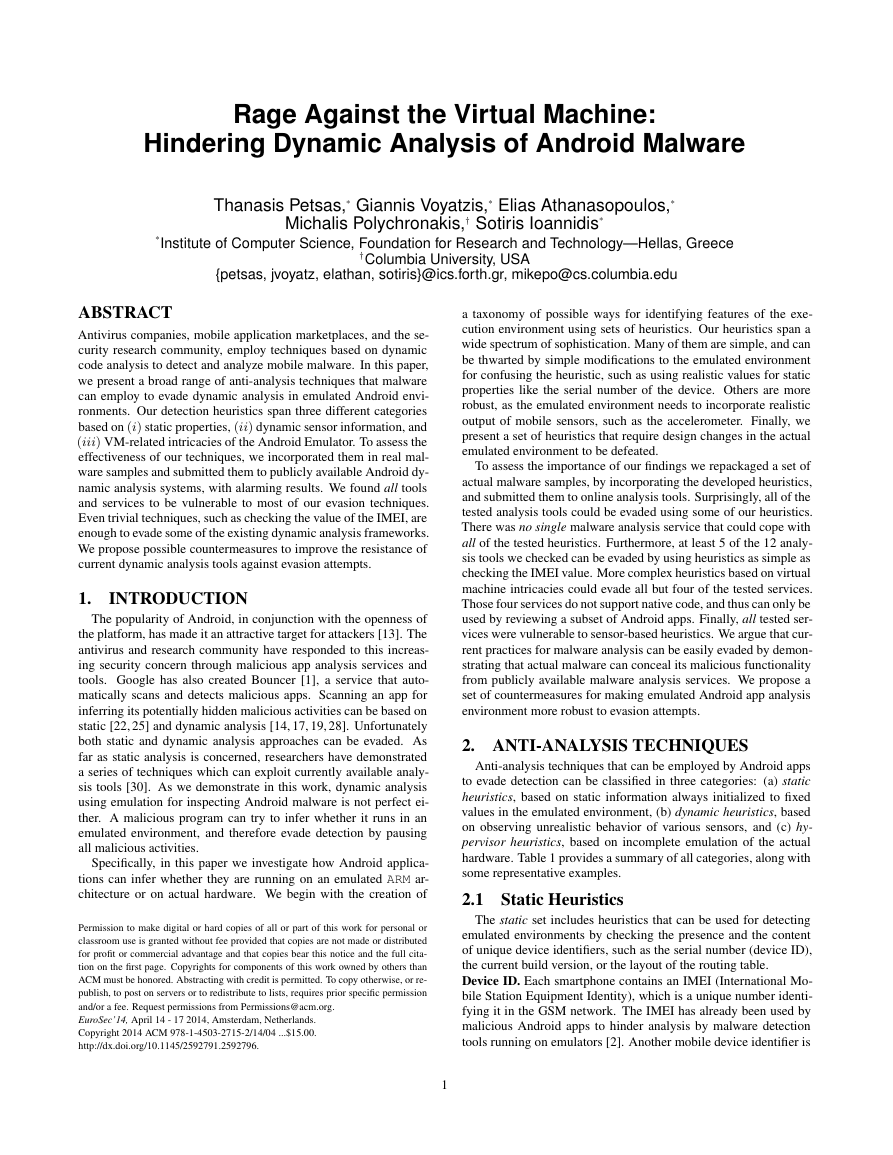
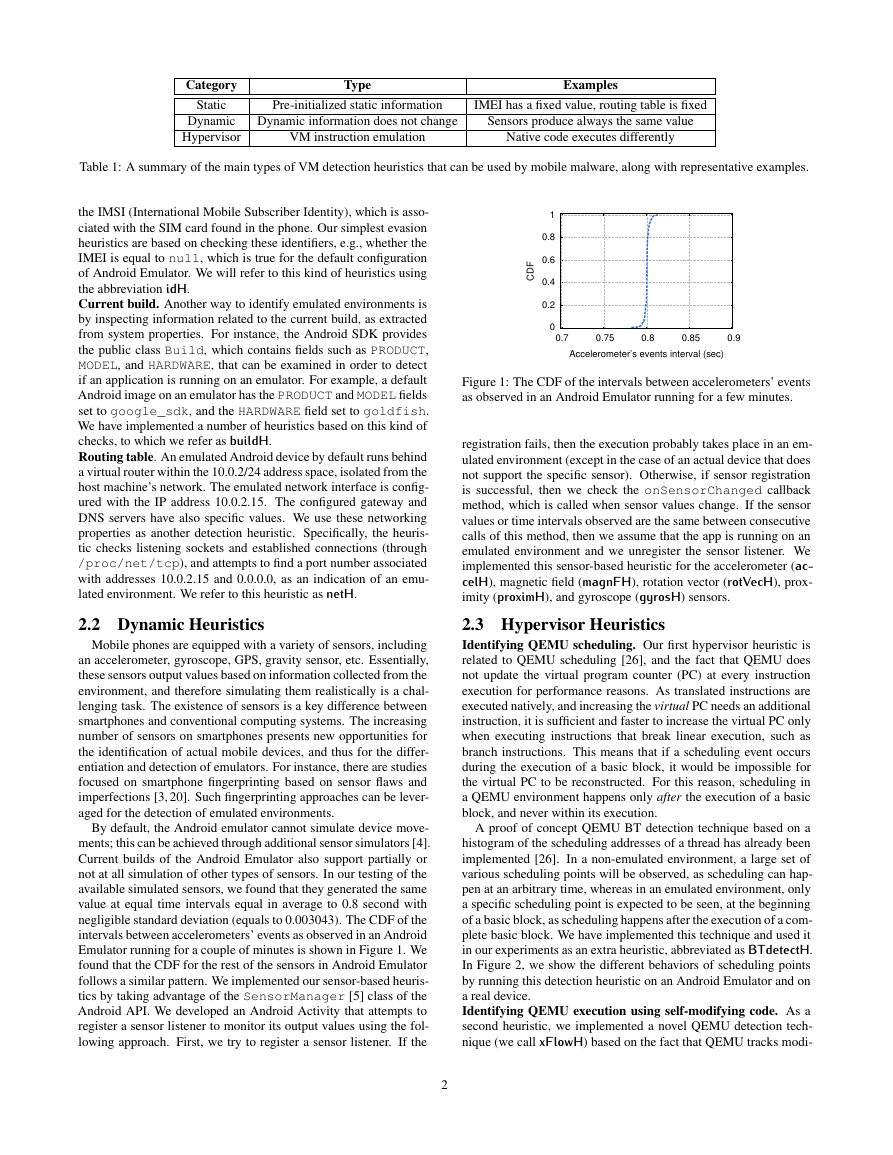
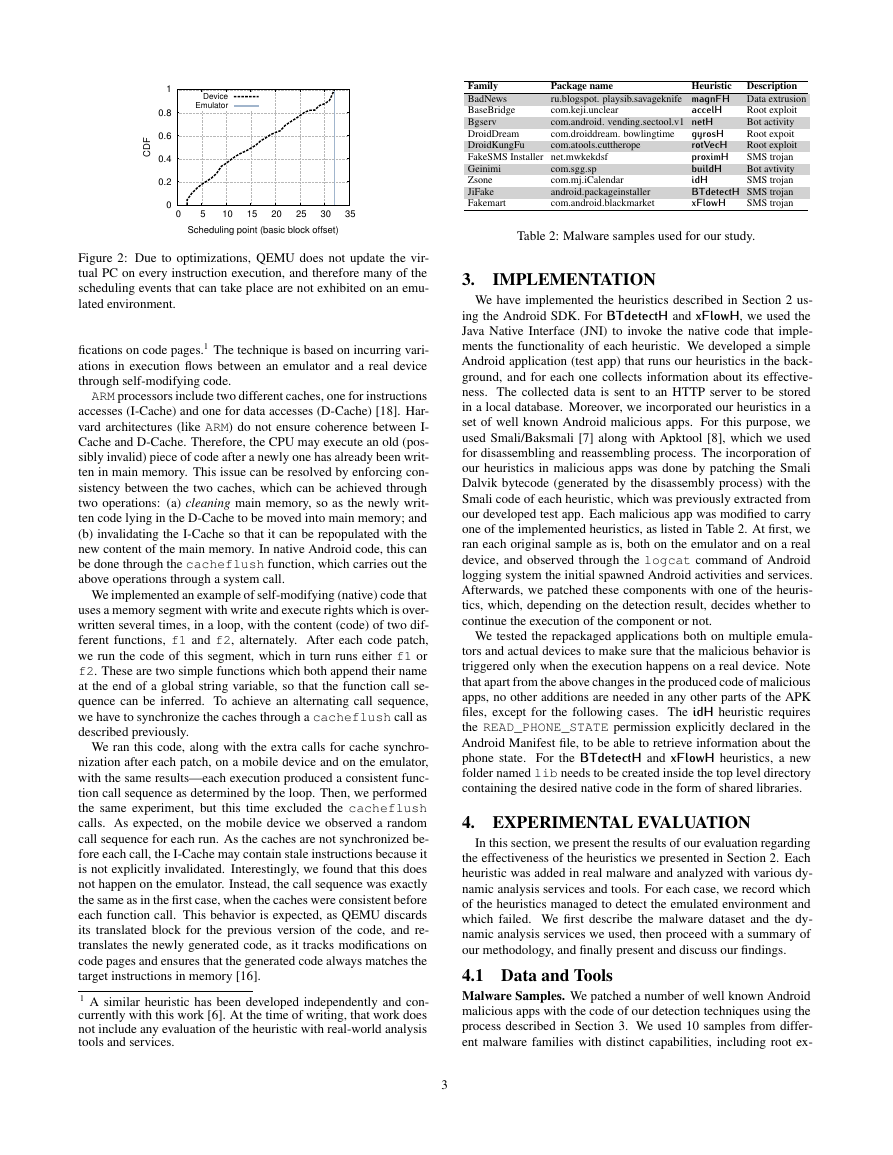
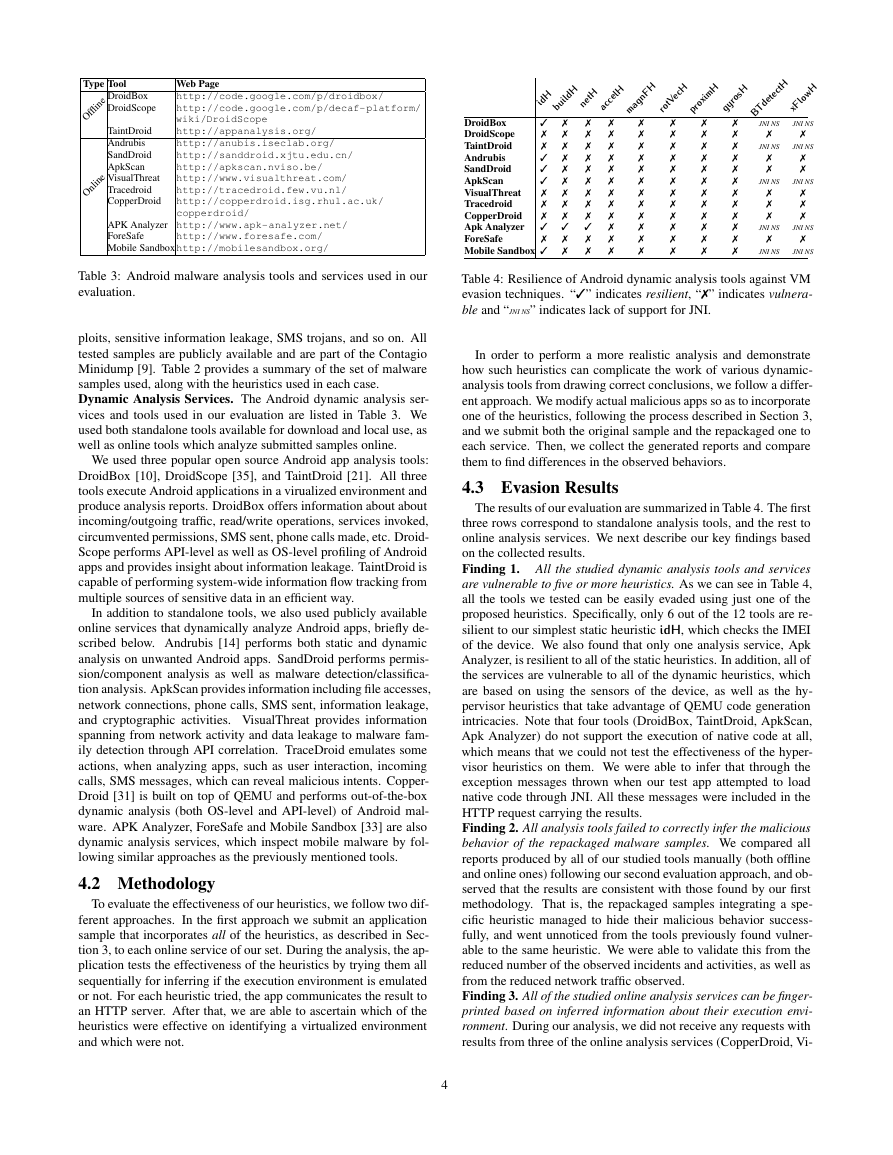
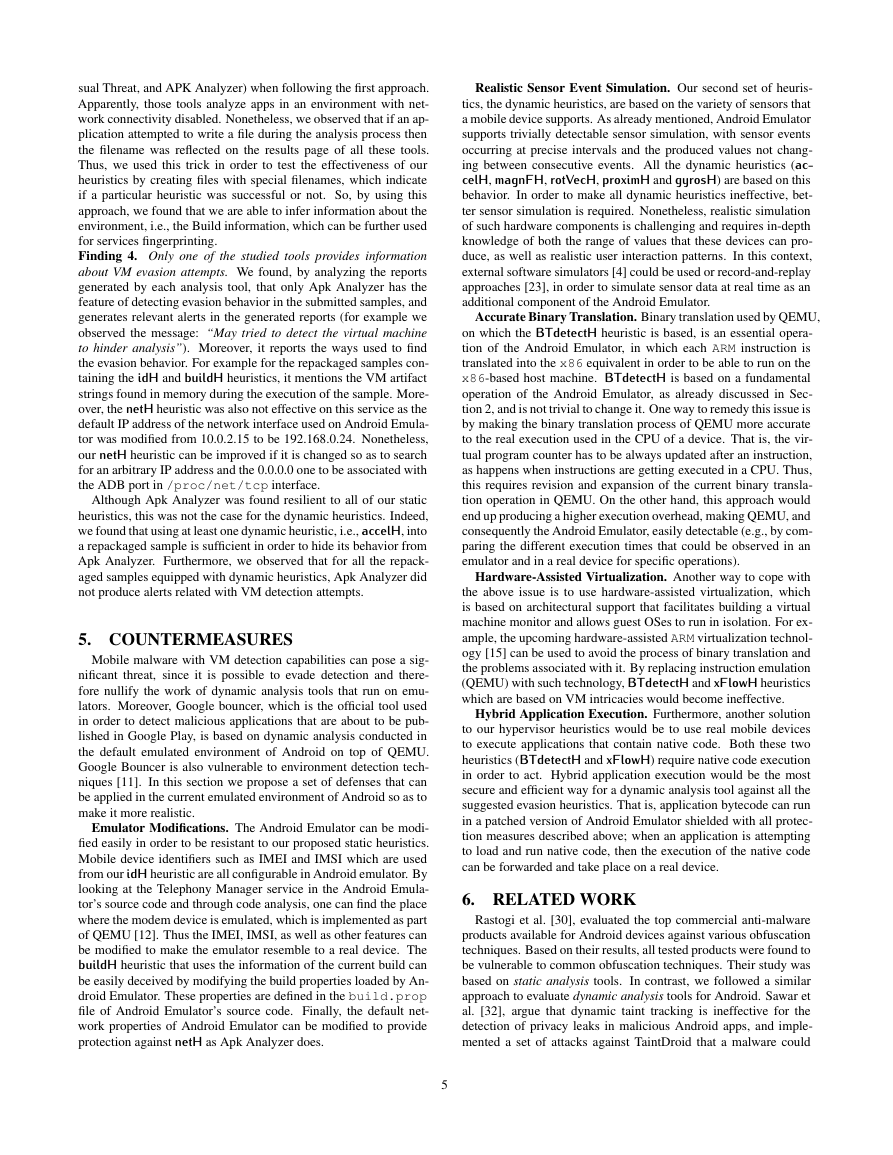
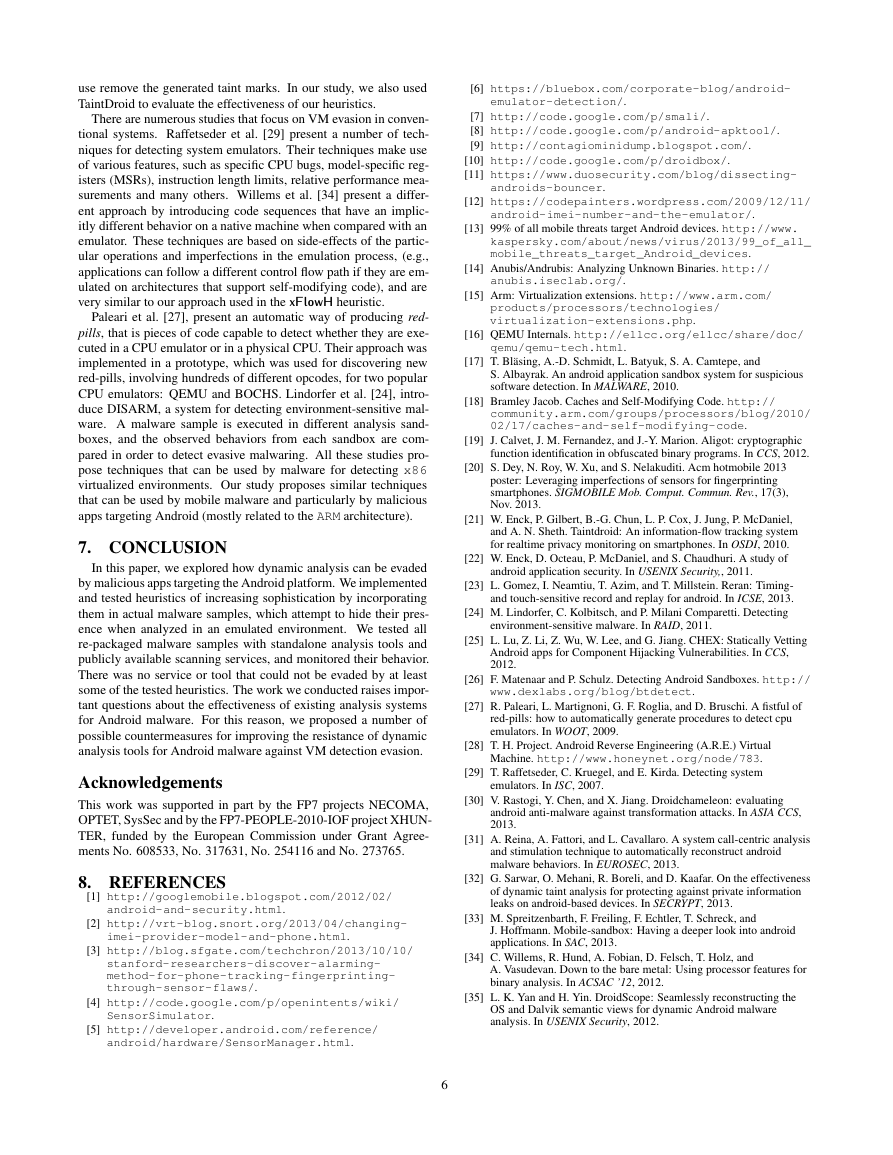






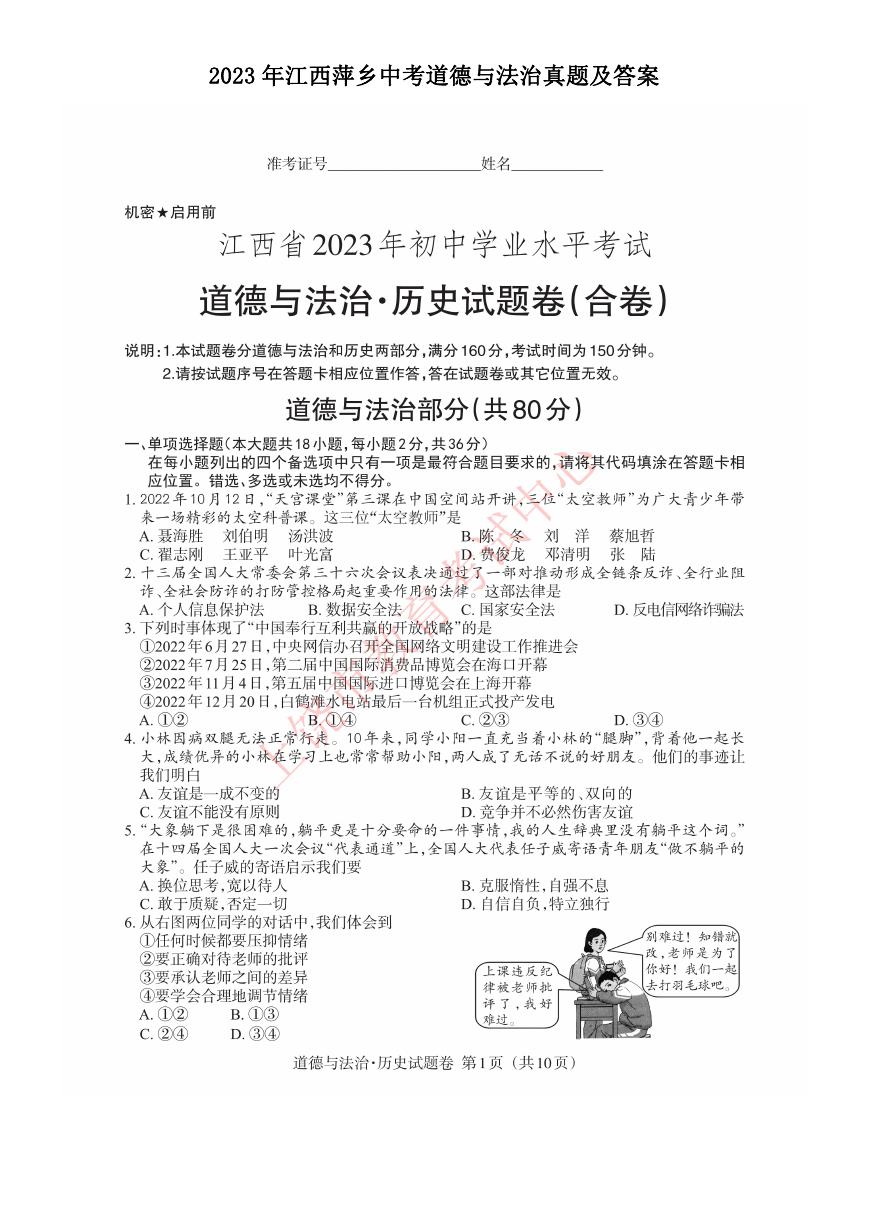 2023年江西萍乡中考道德与法治真题及答案.doc
2023年江西萍乡中考道德与法治真题及答案.doc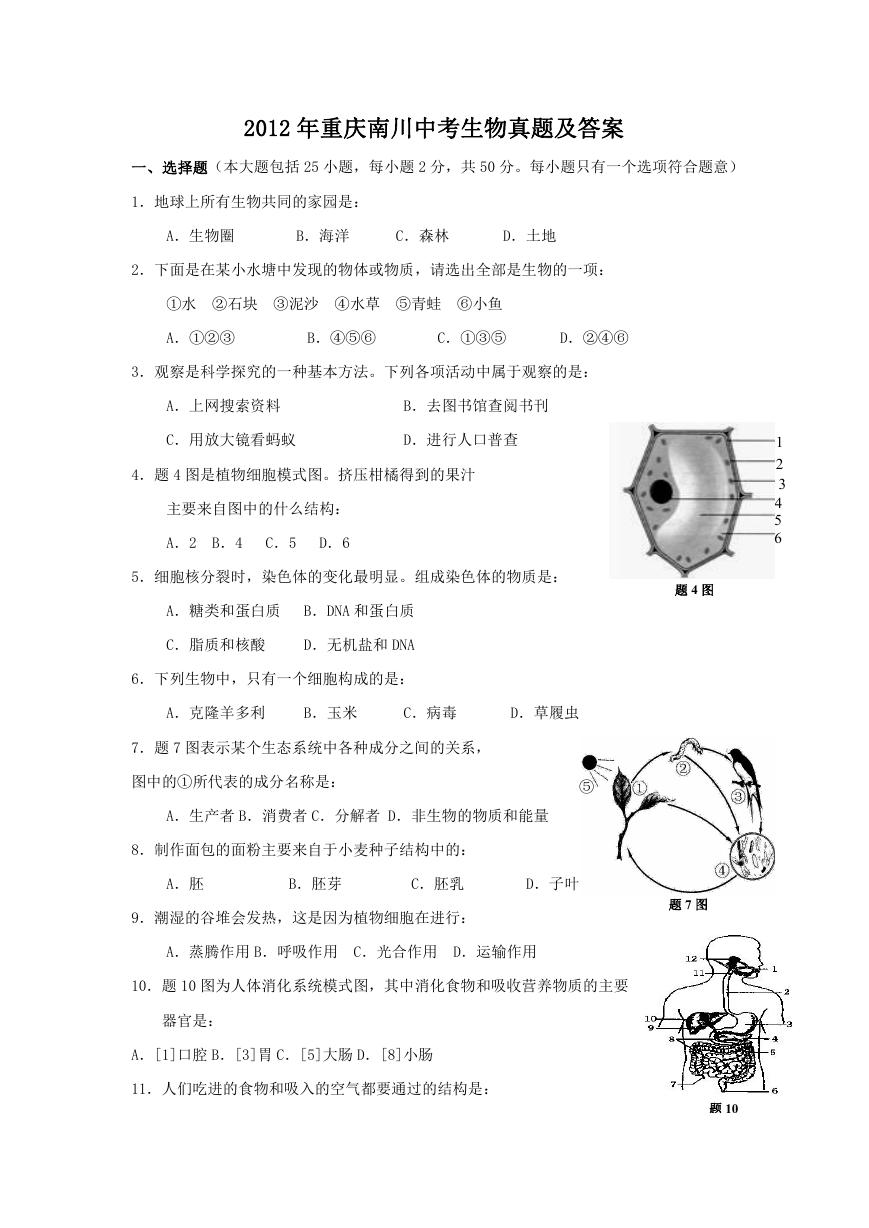 2012年重庆南川中考生物真题及答案.doc
2012年重庆南川中考生物真题及答案.doc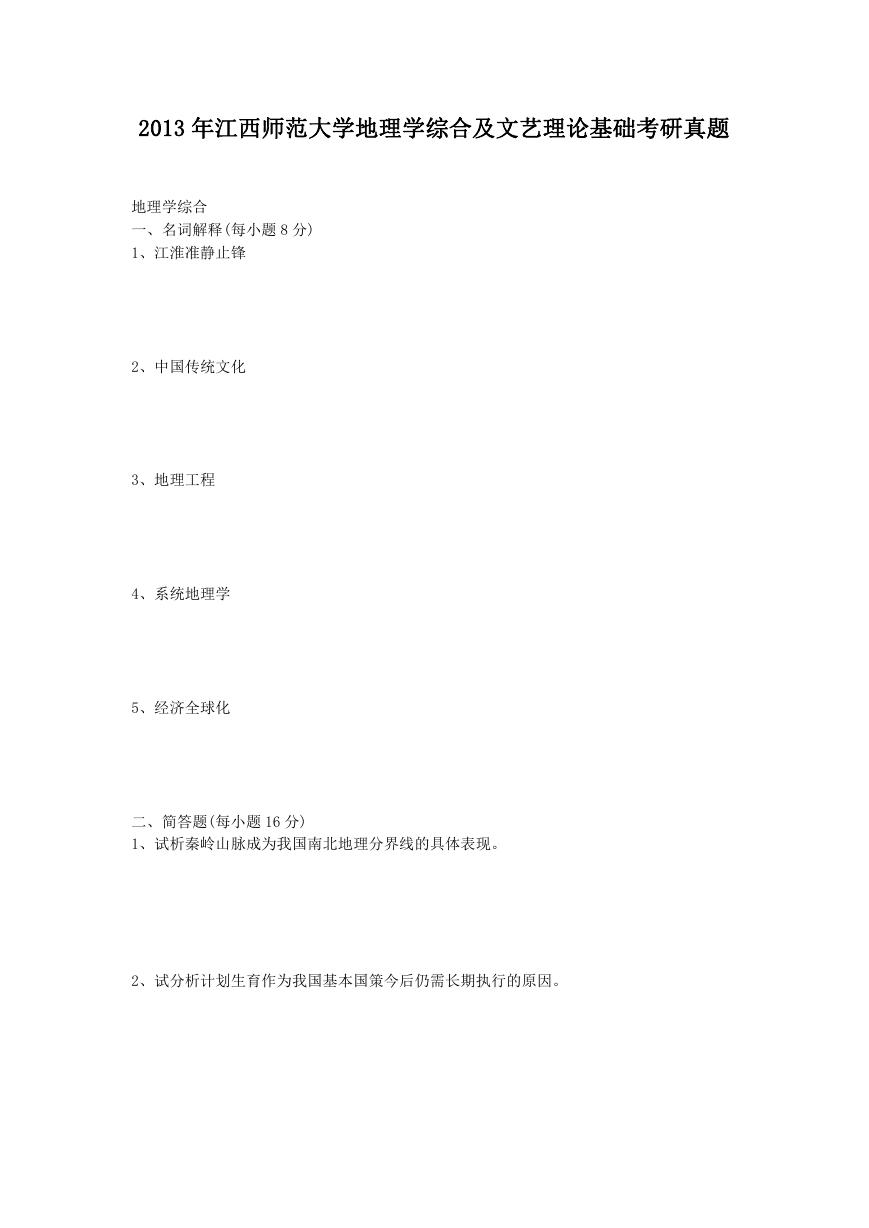 2013年江西师范大学地理学综合及文艺理论基础考研真题.doc
2013年江西师范大学地理学综合及文艺理论基础考研真题.doc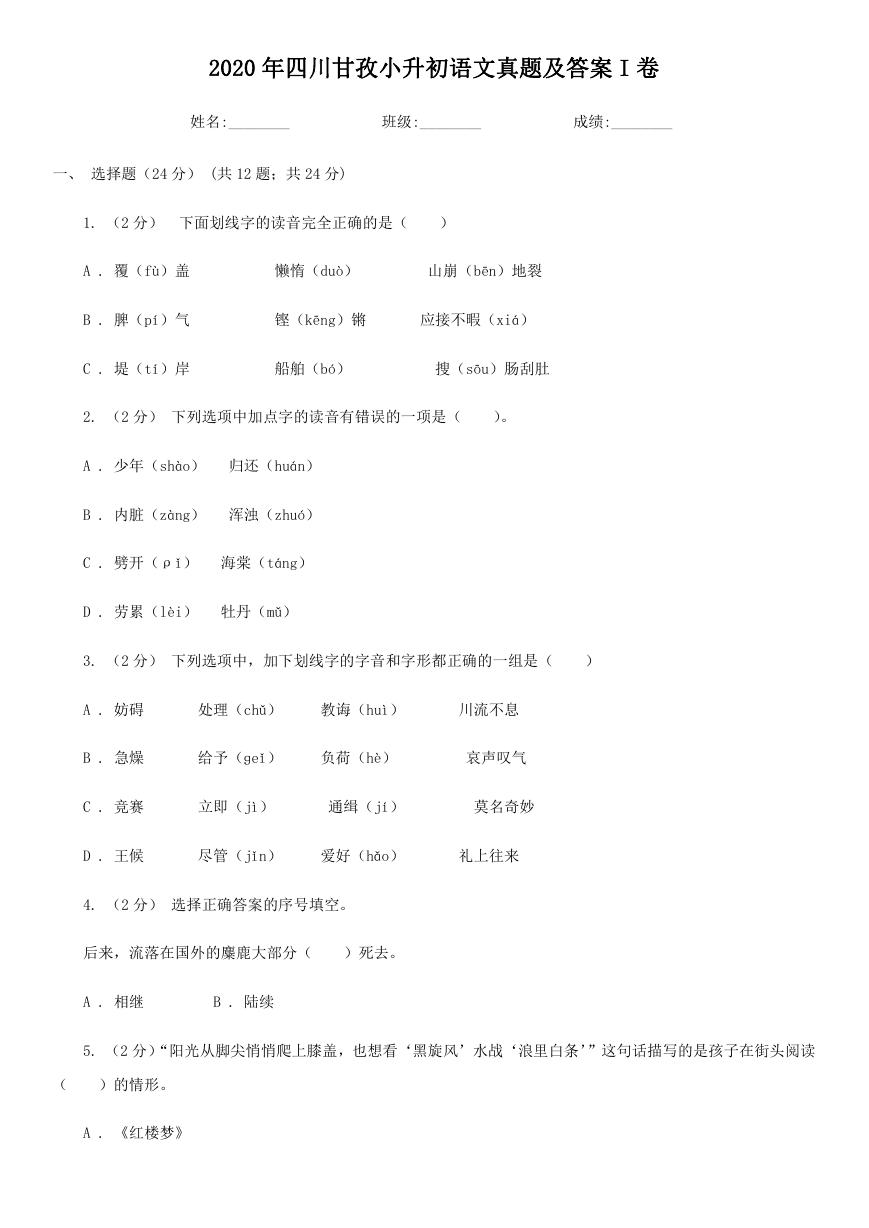 2020年四川甘孜小升初语文真题及答案I卷.doc
2020年四川甘孜小升初语文真题及答案I卷.doc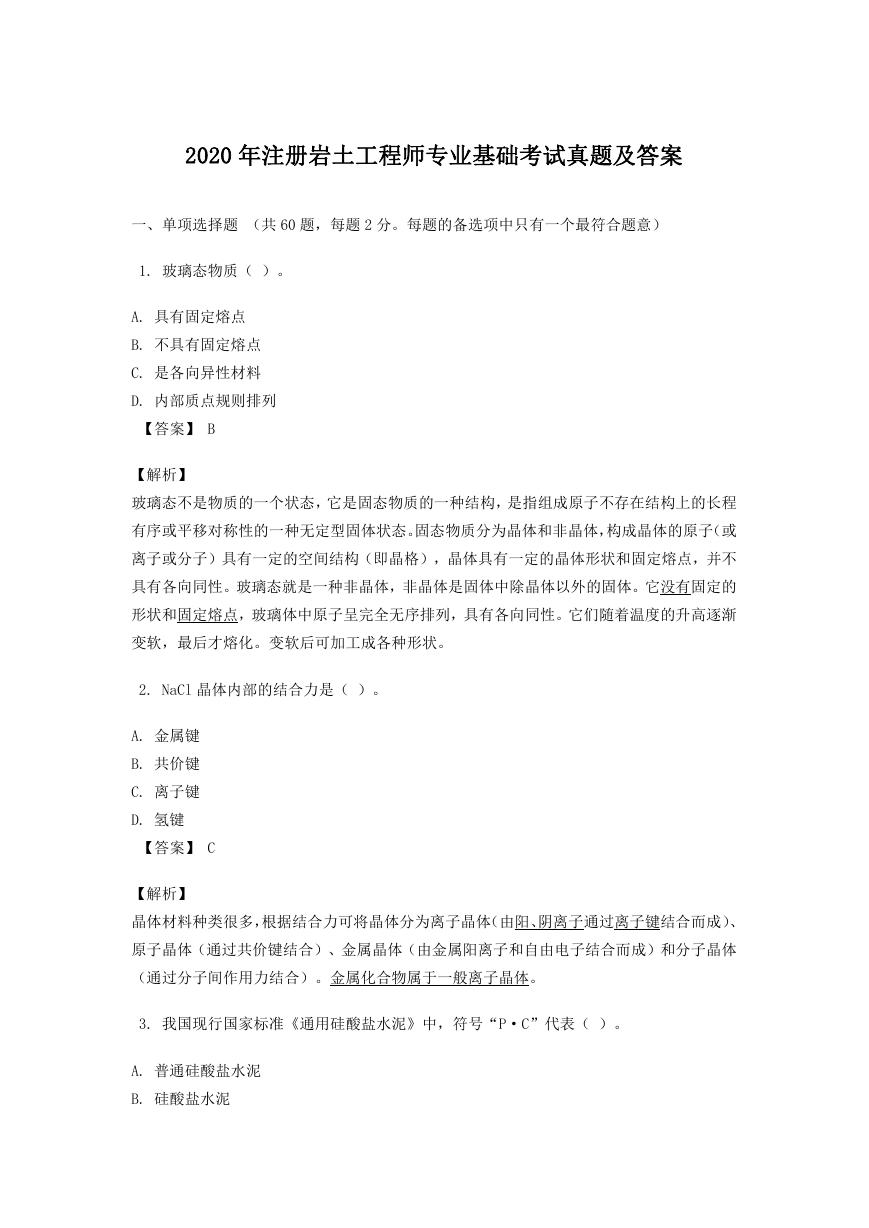 2020年注册岩土工程师专业基础考试真题及答案.doc
2020年注册岩土工程师专业基础考试真题及答案.doc 2023-2024学年福建省厦门市九年级上学期数学月考试题及答案.doc
2023-2024学年福建省厦门市九年级上学期数学月考试题及答案.doc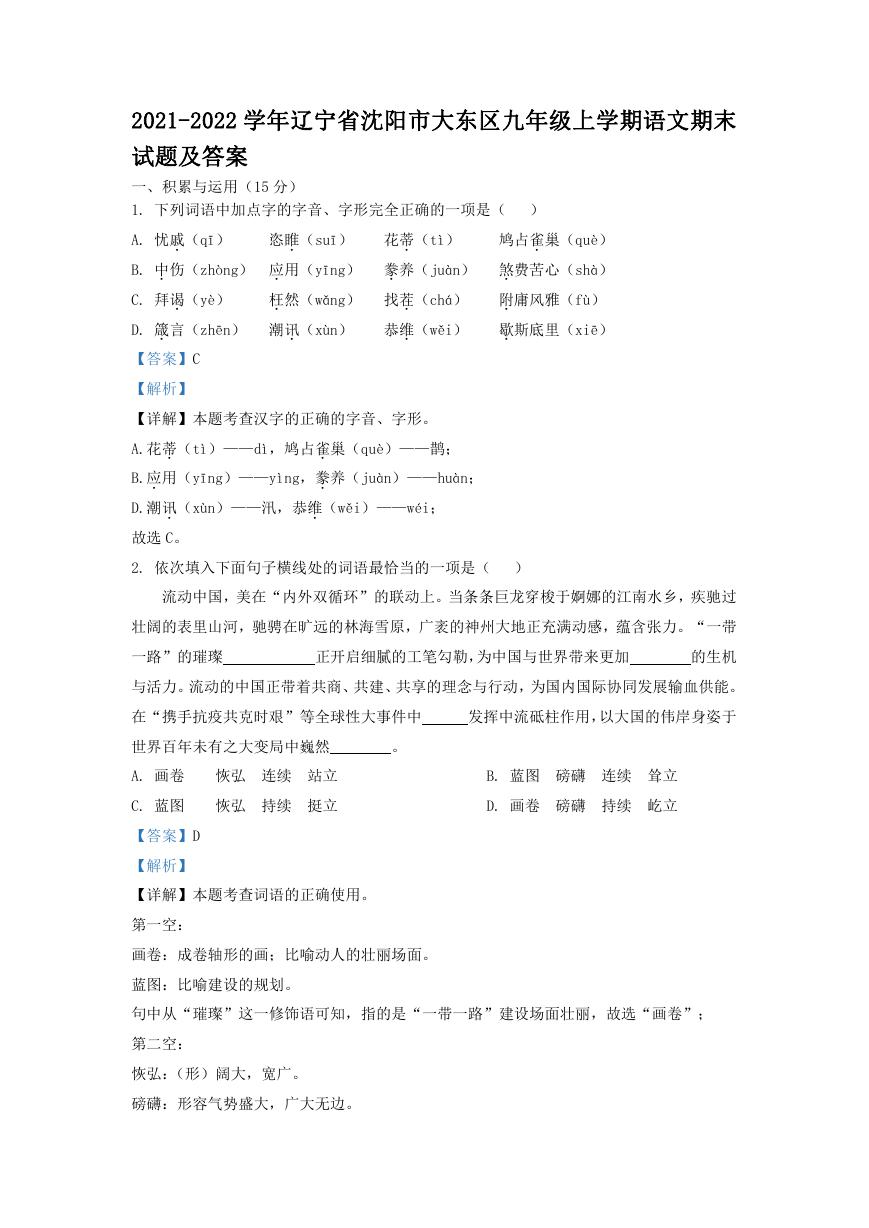 2021-2022学年辽宁省沈阳市大东区九年级上学期语文期末试题及答案.doc
2021-2022学年辽宁省沈阳市大东区九年级上学期语文期末试题及答案.doc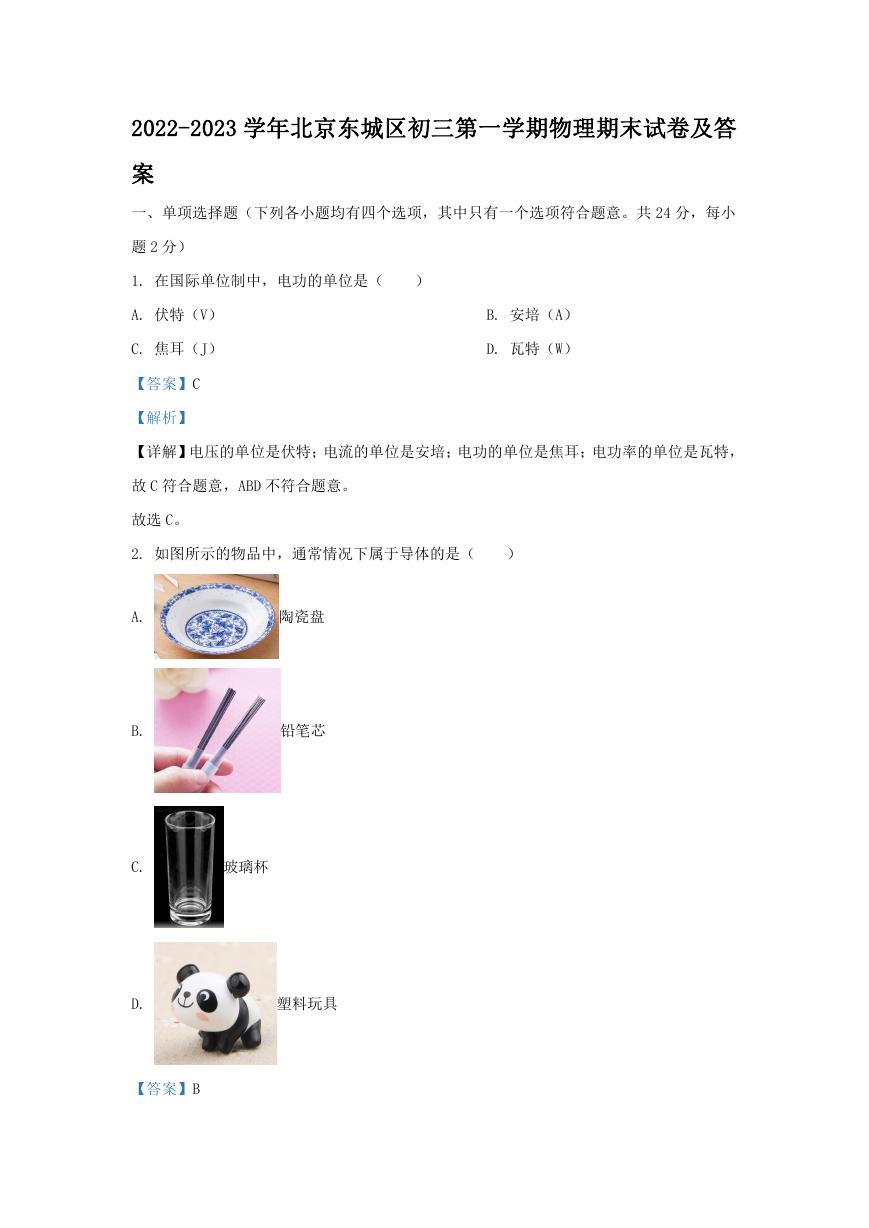 2022-2023学年北京东城区初三第一学期物理期末试卷及答案.doc
2022-2023学年北京东城区初三第一学期物理期末试卷及答案.doc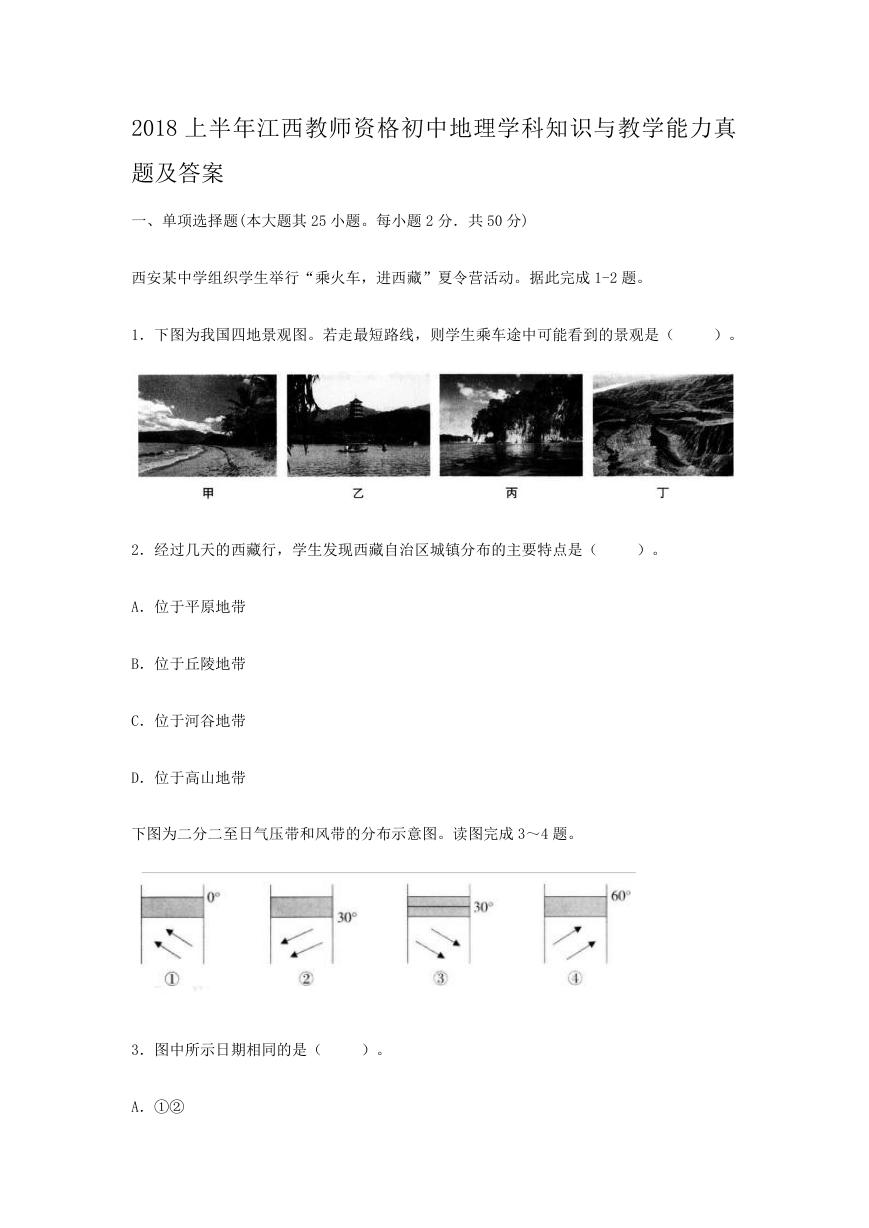 2018上半年江西教师资格初中地理学科知识与教学能力真题及答案.doc
2018上半年江西教师资格初中地理学科知识与教学能力真题及答案.doc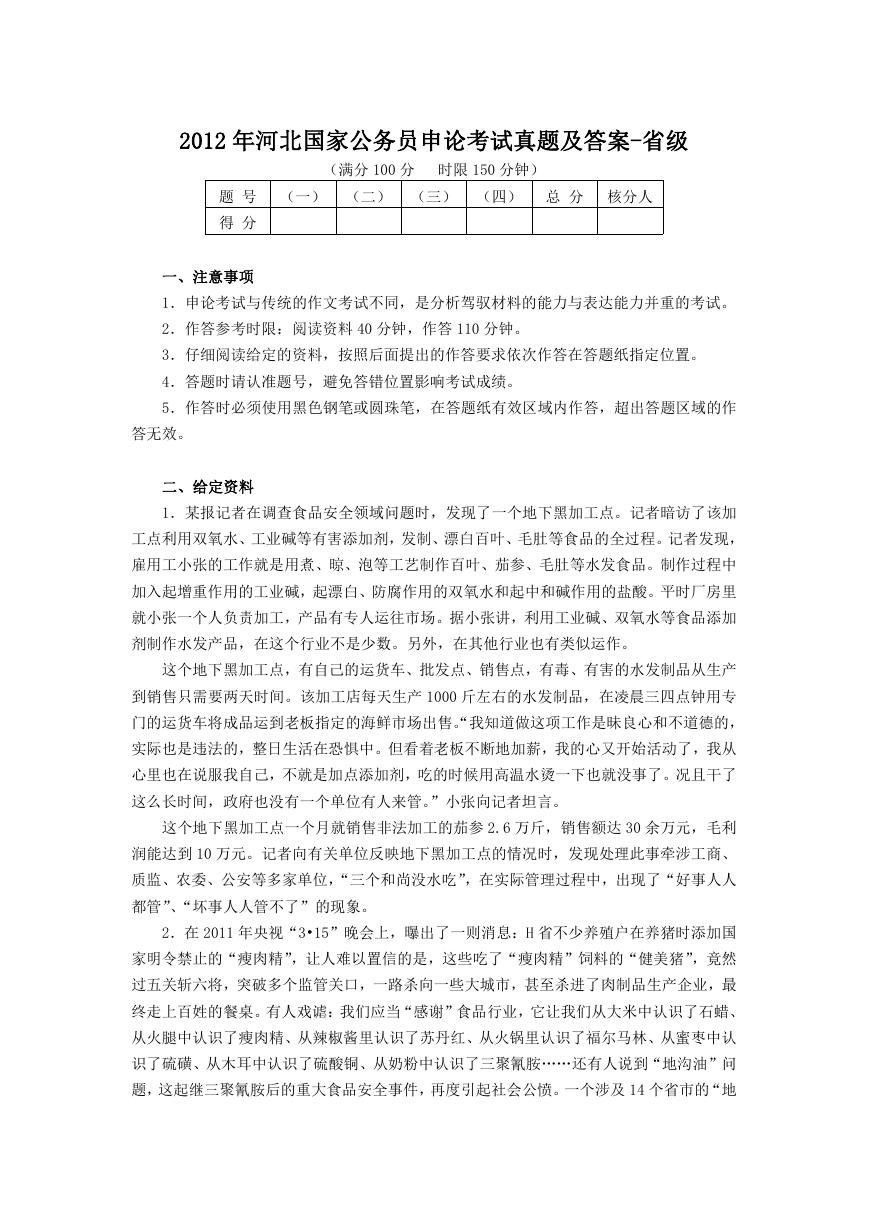 2012年河北国家公务员申论考试真题及答案-省级.doc
2012年河北国家公务员申论考试真题及答案-省级.doc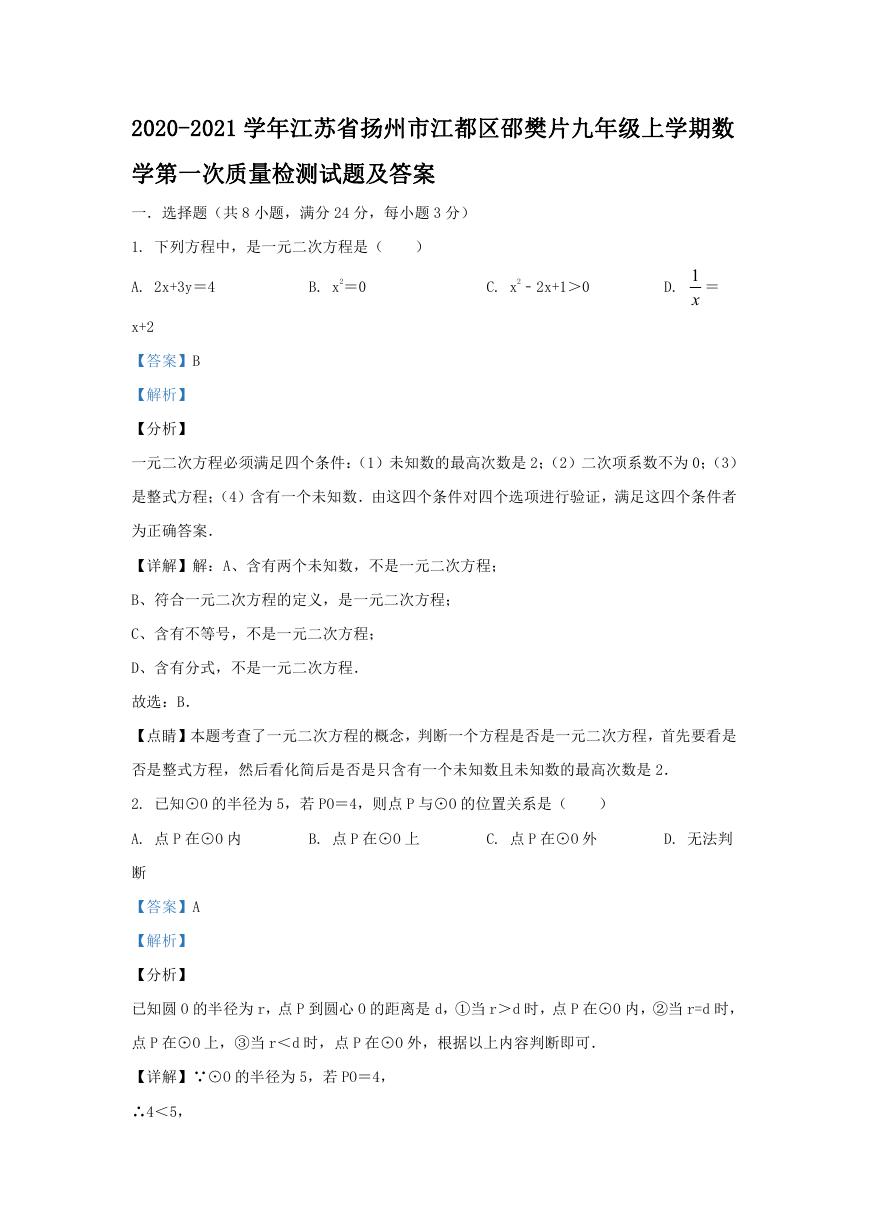 2020-2021学年江苏省扬州市江都区邵樊片九年级上学期数学第一次质量检测试题及答案.doc
2020-2021学年江苏省扬州市江都区邵樊片九年级上学期数学第一次质量检测试题及答案.doc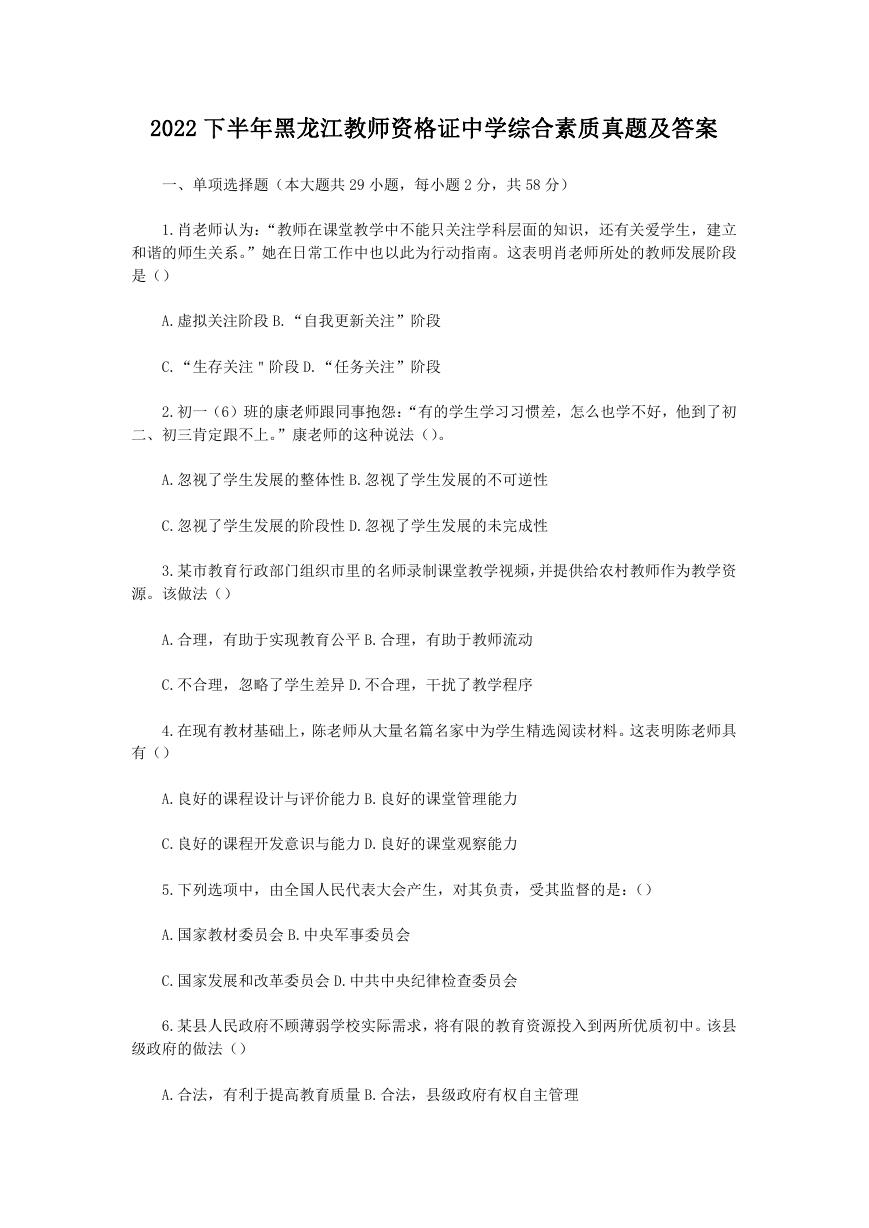 2022下半年黑龙江教师资格证中学综合素质真题及答案.doc
2022下半年黑龙江教师资格证中学综合素质真题及答案.doc